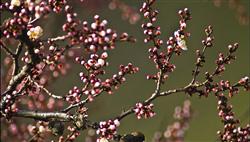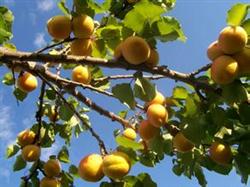Technical measures to improve the fruit setting rate of apricot trees

First, select excellent varieties. Selecting the varieties with high complete flower ratio, strong self-fruiting ability, frost resistance, late flowering, early fruit and high yield as the main varieties is the key to improve the fruit setting rate. For example, Golden Sun, Kate Apricot and so on. In addition, early, middle and late maturing varieties can also be selected to reduce the loss caused by early spring frost. Second, configure pollination trees. Varieties can not be too single, some varieties are self-fertile, need to be equipped with 2-3 varieties for pollination. The ratio of pollination trees to main varieties should be 1:3-4. Third, strengthening the management of soil, fertilizer and water, strengthening the tree potential, increasing the accumulation of tree nutrients and improving the quality of flower buds are effective measures to reduce flower organ abortion, increase fruit setting rate and increase yield. The base fertilizer should be applied in autumn, and it should be applied as soon as possible from September to October combined with hole expansion. In the young tree period, the whole garden should be turned over once in 3-4 years. When turning deeply, try to reduce the damage to the root, especially the backbone root. The base fertilizer is mainly stable manure, compost, human feces and urine, and the amount of fertilizer should be flexibly controlled according to tree age, tree potential, fruit yield and types of fertilizer. On the basis of applying base fertilizer in autumn, topdressing fertilizer should be applied timely: before ⑴ sprouting (from late March to early April), urea 15kg / mu + N, P, K compound fertilizer 450kg / mu, hole application or furrow application, and the growing period of new shoots and flower bud differentiation period of apricot trees in mid-late May were the critical period of apricot fertilizer requirement. The fruit trees were topdressing urea 100-1205 kg / mu, ring spreading or furrow application, ⑶ fruits were topdressing with compound fertilizer dominated by nitrogen fertilizer, fruit trees were topdressing with N, P, K compound fertilizer 0.5kg / plant. In order to supplement the nutrient consumption of the tree in time, it is necessary to fertilize the apricot outside the root. ⑴ sprayed the branches with 0.5-1% urea solution before flowering. ⑵ sprayed 0.3% borax and 0.3% urea solution at full bloom to increase the fruit setting rate. ⑶ sprays 0.3% urea + 0.3% potassium dihydrogen phosphate solution after flowering. Spraying 10 × 10-4B9 40 days after flowering in ⑷ could increase the first class flower ratio and fruit setting rate. ⑸ fruits were sprayed with 0.3-0.4% potassium dihydrogen phosphate in the first half of ripening to promote fruit coloring. 4. releasing bees and artificial pollination in flowering orchards. Apricot trees are insect-pollinated flowers, and bees and other insects can help pollinate. Putting bees in the apricot orchard can obviously increase the fruit setting rate. Due to the short flowering period of apricot, in case of low temperature, cloudy weather, rainfall or strong wind and other adverse weather, insect activity is blocked, it will affect pollination, so it is necessary to carry out artificial pollination. Artificial pollination uses the pollen of mountain apricot (large pollen quantity and strong pollen viability). The pollen and starch are mixed at 1:2 and then dipped in the rubber head of a brush or pencil and placed on the stigma of the flower. 5. Delay flowering and avoid frost. Because apricot trees are vulnerable to late frost at flowering stage, the fruit setting rate is low. To this end, we adopt: ⑴ trunk whitening plus spraying 8% lime water in the crown or repeated irrigation in early spring to reduce soil temperature, delay germination, and delay flowering by irrigation before flowering. ⑵ full bloom frost can be sprayed 350x before the arrival of frost, or flowering spray water (water freezes, to release heat) or smoke measures to prevent frost. When frost weather is predicted, the smoke pile is lit at 2: 00 at night, so that the temperature of the apricot orchard will not drop below zero. ⑶ re-pruning. Some varieties (such as red purse) in summer re-pruning can promote secondary branches, secondary branches grow to 30 cm after coring can promote three branches, or even four branches, so that the florescence of the first, second, third and fourth branches can be prolonged by 5-7 days, even after the first batch of jelly, the flowers on the second, third and fourth branches can avoid the late frost and greatly improve the fruit setting rate. 6. Girdling of young trees. The suitable period for ring peeling is in the middle of May. The width of the main ring peeling mouth is 25-1 stroke 30 of the thickness of the dry diameter. The peeling mouth is smeared with 25% carbendazim 100 times solution and bandaged with plastic film (which can effectively reduce glue flow and promote wound healing). One week after peeling, 0.3% urea solution was sprayed twice, once a week, and then 0.3% potassium dihydrogen phosphate solution was sprayed twice, each time at an interval of one week. Girdling can effectively increase the flower yield and fruit setting rate of young trees in the following year.
- Prev

Flower and Fruit Management of Apricot
First, artificial pollination of apricot trees depends on bees and other pollination. However, experience shows that artificial pollination can increase the fruit setting rate by 3-4 times compared with natural pollination. Artificial pollination should be carried out in full bloom, because the apricot florescence is very short (5-7 days), should be prepared in advance. Apricot pedicel fragile and easy to break, pollination should be extra.
- Next

To improve the fruit setting rate of apricot trees, rational fertilization is necessary.
"Yunda Quan Fruit" is a new special growth aid for the balance of vegetative growth to reproductive growth on fruit trees and fruit vegetables (such as tomatoes, eggplants, melons, etc.). Its main features are: ① non-toxic performance, so that the fruit does not leave any residual poison, to achieve pollution-free, become a green rest assured product. ② promotes flowers quickly and quickly.
Related
- Moge, come on! The staff of the peasant association in the producing area of cantaloupe were frightened when the crowd gathered.
- Causes and Solutions of low Fruit setting rate of Apple
- Symptoms and control measures of passion fruit virus disease
- Fruit growing lesson: how do apple orchards keep high yields?
- Can you build orchards in the mountains? What are the pros and cons?
- How to manage the coloring period of Crisson grape?
- This paper introduces the processing technology of two kinds of fig products.
- How much is a month for retired teachers in rural areas by 2020?
- How can strawberry planting increase sugar content? We should pay attention to management in many aspects.
- What are the cultivation techniques on how to improve the yield of golden fruit?

